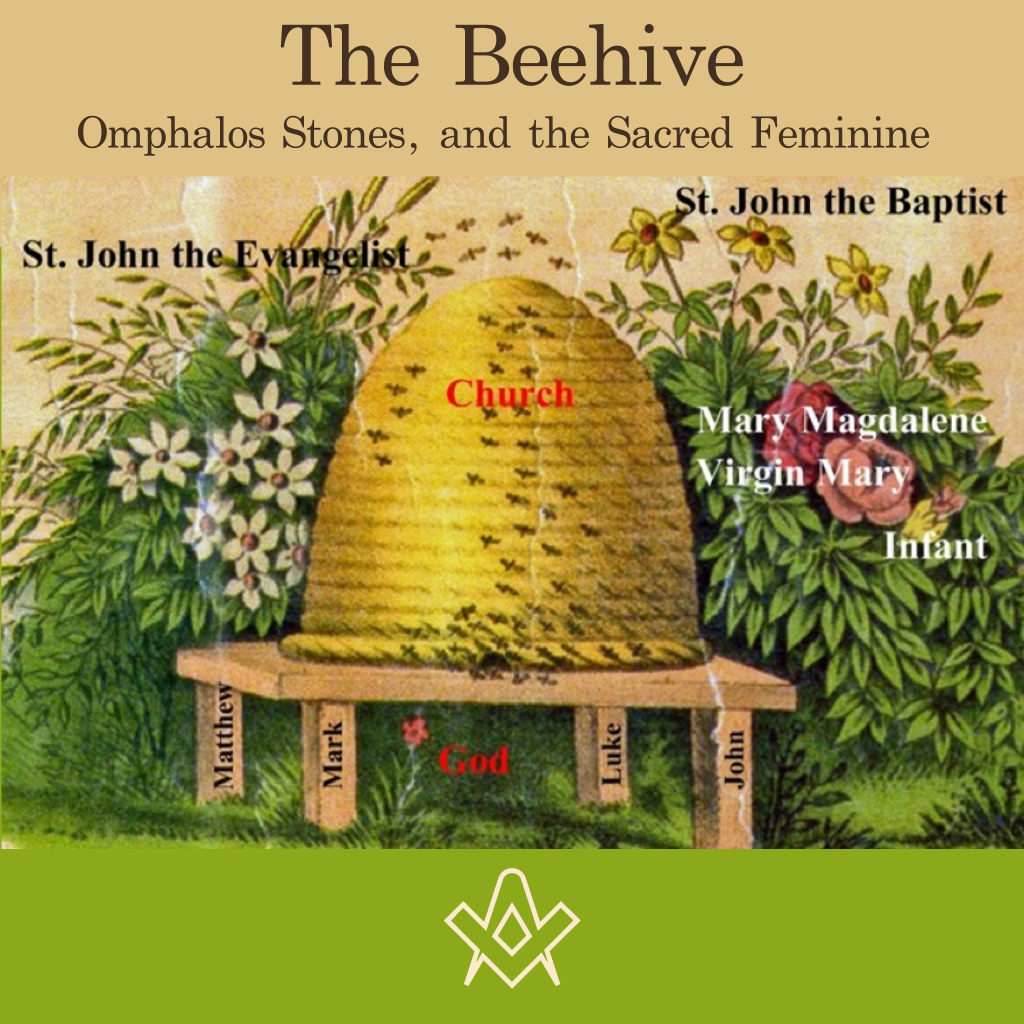The Beehive, Omphalos Stones, & the Sacred Feminine
This paper addresses symbolism of the beehive in Masonry and its association with omphalos stones and the sacred feminine.
R.E. Kretz, PhD
January 2020
The Beehive
In Masonry we are taught that the beehive is a symbol of industry, one where an individual contributes to the betterment of the collective whole without contention.
‘In alchemical symbolism the beehive represented the lab (or Lodge), where the bees (Masons) bring raw materials they have collected from the Earth in order to transmute them into golden honey (lead into gold).’ [i]
In another alchemical sense a beehive is symbolic of the Christian church. The Church’s clergy go forth to spread its gospel, pollenating the hearts and minds of the masses, transforming their spirituality.
In Masonry we find this referenced in Sherer’s Master’s Carpet [ii] where the beehive is depicted in the third section of the Master Mason lecture.
Here we find the beehive emphasizes Marianist and Johannine traditions within the Church, the sacred feminine.
In Sherer’s depiction the Church (beehive) is supported by and rests upon the four pillars of the New Testament: Matthew, Mark, Luke, and John.
The solitary flower under the hive is a Dianthus. Named by the Greek botanist Theophrastus, Dianthus means ‘flower of God’ [iii] and as such symbolizes God in this image while alluding to the sacred feminine. [iv]
On the left the hive is surrounded by cereal and daisies symbolizing St. John the Evangelist.
To the right we find St. John’s Wort representing St. John the Baptist, along with two roses and a rosebud signifying Mary Magdalene, the Virgin Mary, and an infant.
Allegorically, Sherer’s depiction of a beehive appears suggestive of the Cathedral Notre Dame de Chartres in France.
We’ll discuss Chartres further momentarily.
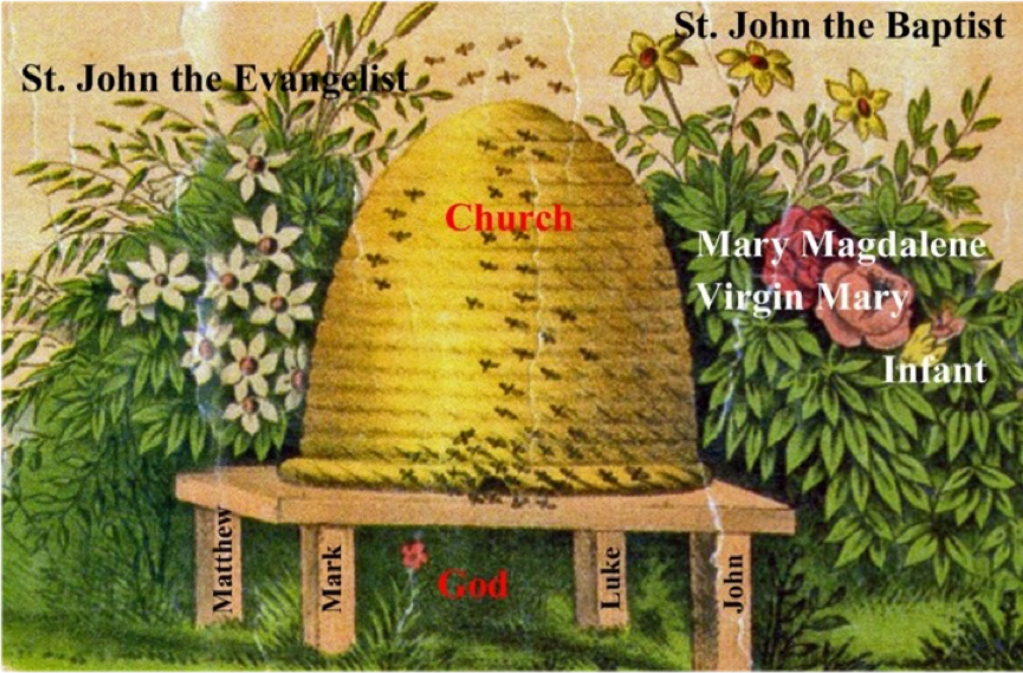
Beehive depicted in Sherer’s Master’s Carpet as annotated by the author
IMAGE CREDIT: the author
That a beehive is symbolic of a Marianist tradition within the Christian church is derived from veneration of the sacred feminine in the remote past.
In nature a beehive is dedicated to its one queen who resides within its dark recesses.
The worker bees who build the hive, pollenate plants, bring nectar and pollen to the hive for conversion into food (honey), defend it, tend the young, and care for the queen are all female.
There are few male bees, called drones, in a hive. A drone’s sole purpose is to fertilize a virgin queen during her one and only mating flight.
That’s it! Typically, drones don’t participate in worker bee behaviours. They can’t even sting in defence of themselves or the hive!
If a hive’s queen should die prior to her replacement the worker bees can create a new queen through parthenogenesis.
What this means is that because female worker bees aren’t fertile the new queen is born of a virgin.
A further correlation of a queen bee with the sacred feminine is that from the time a new queen’s egg is laid until she emerges, mates, and in turn lays her first worker bee egg is 28 days [v].
Thus, a queen bee’s development from conception to reproduction requires a full lunar cycle, as does a woman’s menstrual cycle, epitomizing sacred feminine connectivity with the moon.
Therefore, in the minds of our ancient ancestors, such a queen residing in the dark recesses of a hive symbolized the supreme Earth mother, queen of the underworld who resided in caves, and because she could fly and was connected with the moon she was also the queen of heaven.
In Christian terms this correlates with the Virgin Mary and Mary Magdalene and supports the Hermetic axiom of as above, so below.
The importance of bees symbolizing the sacred feminine in ancient cultures is demonstrated by Charlemagne’s ancestor, Childeric I, son of Meroveus who founded the Merovingian dynasty.
Childeric was interred with approximately 300 gold bees on his cloak. Napoleon later used Childeric’s bees as symbols of the French Empire.

A bee’s egg is laid in a hexagonal cell
IMAGE CREDIT: Photographs by the author who is a beekeeper
A bee’s egg is laid in a hexagonal cell. Allegorically monk’s and nun’s quarters are also referred to as cells.
A queen’s cell is bell-shaped, hollow inside, an allegorical womb, and similar in appearance to an omphalos stone.
As larvae a queen bee is fed only ‘royal jelly’. A queen bee is larger and has a longer abdomen than a worker bee.
She can fly and sting, but only leaves her hive once in her life. When she does so it is for about two days during her mating flight.
In this image a queen is marked with a green dot to indicate the year she hatched. [vi]
Omphalos Stones
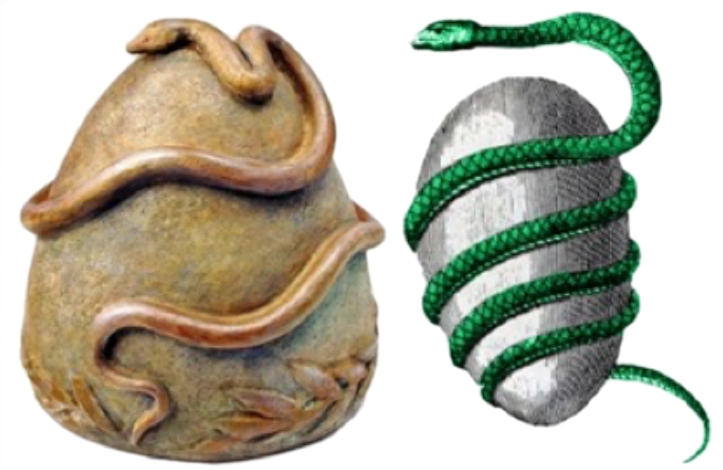
Serpent wrapped omphalos stone at Delos (left) and Orphic Egg (right)
IMAGE CREDIT: by author
Omphalos stones are beehive or queen cell shaped stones that represent the supreme Earth mother.
As such, they symbolize an egg. When wrapped by a serpent, such as the stone at Delos in Greece, an omphalos symbolizes a Cosmic Egg also known as an Orphic Egg.
The serpent acts as an umbilical cord, connecting the egg to the universe.
It is within an egg that life begins, changing in form as it grows until it emerges at birth from darkness into light, epitomizing alchemy as the Philosopher’s Stone.
It has also been suggested that the coiled serpent represents electromagnetic energy encircling the globe.[vii]
Over time beehive shaped omphalos stones evolved as pillars [viii], often in groups of three, and as simulacrums of a virgin mother (Madonna) holding a child.
Omphalos is an ancient Greek word that means ‘navel’. In Latin, the word became ‘umbilicus’ and in Old English nafela, the source of our word ‘navel’.
In the ancient world an omphalos was a sacred object of power that indicated a route to the underworld and allowed direct communication with the gods [ix].
As such, shrines or temples dedicated to the sacred feminine were built at these locations in veneration of the Earth Mother’s mysterious power.
Curiously, these stones are found at ancient sites representing geodetic centres at telluric hot spots along Earth’s ley lines.
Ley lines [x] are naturally occurring paths of low frequency electro-magnetic phenomena flowing in the surface layers of the Earth.
These telluric currents, created by Earth’s rotation and geologic and hydrologic composition, generally flow in the direction of the sun, from east to west.
Their conductance can be measured at various surface points. What these surface points have in common are geologic composition, springs or wells, and hills or mountains.
These sites also tend to resonate at a frequency of about 11 Hz, thus creating a physical sense of euphoria, visions, and healing.
Vinca Culture
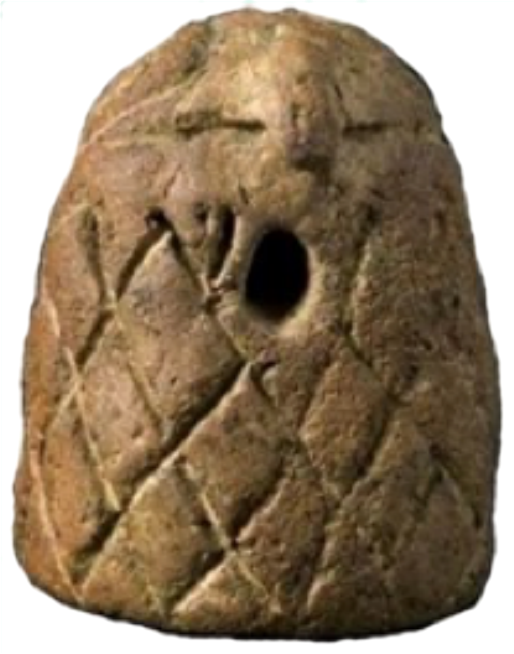
Vinca omphalos stone. Note its similarity to a queen cell.
IMAGE CREDIT: by author
‘Perhaps surprisingly, the oldest known ‘omphalos’ is on view in the Sofia Museum, Bulgaria. It is from the Vinca culture which dates between 3,000 to 5,000 BC.
Many Vinca buildings were found to have had an ‘omphalos’ area set aside in them.
The Vinca culture dissipated from ‘Old Europe’ c. 3,500 B.C., vestiges of the same culture can be seen around the Mediterranean basin and beyond.’ [xi]
Delphi
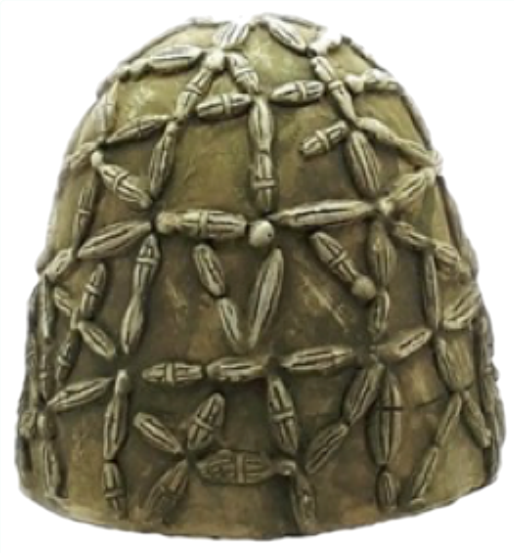
Omphalos at Delphi
IMAGE CREDIT: by author
One of the best-known omphalos stones is the Oracle at Delphi.
It dates to approximately 1400 B.C. and is situated on a ley line underneath a temple to Apollo located high on the slopes of Mount Parnassus where a sacred spring emanates from a deep vaporous cavern.
To the Ancient Greeks Delphi was the navel, the centre, of the world. The omphalos at the museum in Delphi is a restored hollow marble-carved stone decorated in high relief in what appears to be a netting or grid pattern similar to a queen cell.
One can’t help but wonder if it’s possible that this grid pattern might also represent Earth’s ley lines as suggested by Sutherland. [xii]
In ancient times the omphalos was kept in the inner sanctum of the temple. It was atop a column supported by a bronze tripod of three dancers. Pausanias suggests that it had two gilded eagles on top of it and that it was protected by a woollen cloth with precious stones in the form of a mermaid. [xiii]
According to Greek mythology the site at Delphi originally belonged to Gaia. Gaia was the Greek equivalent of the Sumerian goddess Ninhursag, a primordial deity who was the ancestral mother of all life and primal Earth goddess.
As such, she was also a chthonic deity to whom black lambs were sacrificed. Gaia is often depicted as a reclining matronly woman holding a baby or surrounded by infant gods who were the fruits of the Earth.
Allegedly the oracle was guarded by Gaia’s giant serpent-dragon child named Python. Apollo usurped Gaia’s chthonic powers by killing Python and took possession of her oracle.
Afterwards Apollo’s priestess assumed the name Pythia, derived from the slaying of Python, and the oracle’s prophetic powers.
In another myth it is said that in an attempt to locate the centre of the Earth, Zeus launched two eagles from opposite ends of the Earth.
From where their paths crossed Zeus threw a stone that landed at Delphi, marking the navel of the world. [xiv]
Jerusalem

Rock Moriah, the Foundation rock, at the Temple Mount
IMAGE LINKED: wikimedia Attribution 4.0 International (CC BY 4.0)
Jerusalem is the navel of Abrahamic religion. Here we find two omphaloi: the Foundation Stone and another at the Church of the Holy Sepulchre.
Another name for a foundation stone is cornerstone. It provides a basis for building. The Foundation Stone in Jerusalem is located in the Dome of the Rock at Temple Mount on Mount Moriah.
According to Jewish tradition the Foundation Stone was the axis mundi, the spiritual junction of Heaven and Earth.
The Talmud says it was from the Foundation Stone that God created the world. It was here that Adam and Eve were created, Abraham was tested, Joseph dreamed, sacrifices were made, where King Solomon built his temple, and Mohammad ascended to Heaven.
One version of the Sumerian myth of Utnapishtim (Noah) suggests that the Ark was a cube that came to rest on a pillar reaching from Earth to Heaven, symbolizing the end of the Great Flood.
In Jewish legend the Ark disappears and is replaced by the Foundation Stone ‘said to lie above the waters that are below the Holy of Holies’. [xv]
This alludes to the Well of Souls, a system of caves said to be a bottomless pit with flowing waters. It is entered by a small hole at the southeast corner of the Foundation Stone.
Allegedly the Ark of the Covenant rested upon an altar on the Foundation Stone within the sanctum sanctorum, or Holy of Holies, of Solomon’s Temple located above the Well of Souls.

Omphalos known as the Compas at the Church of the Holy Sepulchre in Jerusalem By Sergey Serous – Own work, CC BY 3.0
IMAGE LINKED: wikimedia Attribution 4.0 International (CC BY 4.0)
A second omphalos located in Jerusalem is known as the Compas. In contrast to other omphalos, the Compas at the Church of the Holy Sepulchre is inverted.
In this configuration the omphalos allegorically symbolizes the sacred feminine as a womb of the Virgin Mary, the cup of Christ, and the Sangraal.
In the centre of the Compas is a rounded disk embossed with an equilateral cross, similar to a sun disk, indicating that the Church of the Holy Sepulchre is the navel of Christianity.
Allegorically the Compas suggests that Jesus, as the sun and son of God, is within Mary’s womb that represents the divine Earth Mother.
Chartres
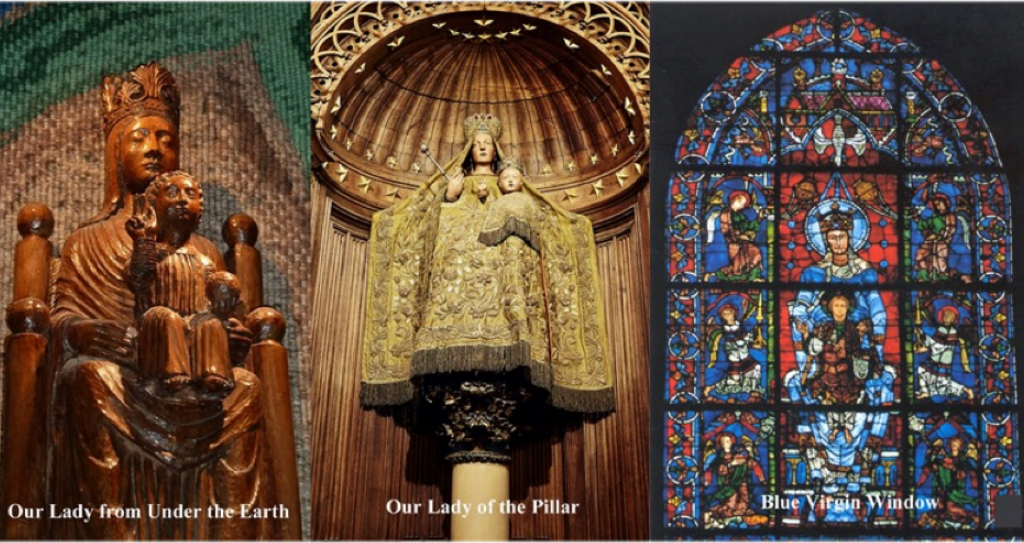
Three aspects of the Madonna as found at the Cathedral Notre Dame de Chartres.
IMAGE CREDIT: by Author
Chartres is the omphalos of the Ardennes forest. It is in the cereal region of France about 50 miles southwest of Paris on the western edge of the ancient Ardennes forest and situated on a ley line linking Stonehenge in England with the Pyramids of Egypt.
Built on the left bank of the Eure River, Chartres was named after the Carnutes, a Celtic tribe in Gaul, who made it their principal Druidic centre.
In the Gallo-Roman period, it was called Autricum, derived from the river Autura (Eure), and afterwards civitas Carnutum, ‘city of the Carnutes’.
In the Middle Ages it became a countship and was held by the Counts of Blois and Champagne, afterwards by the House of Châtillon, and was sold to King Phillip III in 1286.
The Ardennes forest was the centre of the Gaul’s mother goddess, Aard, [1] and the home of the Ardennes family.
The word Ardennes means, ‘Children of Aard’ and refers to a hereditary priesthood lineage. Aard was known as Hathor by the Egyptians and depicted as the great cow of the northern sky that had a cross about her neck.
This cross was called the Cross of Hathor [2] and is common in Merovingian and Celtic graves.
‘Aard is actually the very ancient name of the mother goddess of the ancestors of the Egyptians – not just Kushites from the kingdom of Babylonia, but the Persian kingdoms before them, and even more ancient civilizations before them.
According to temple lore, Aard was the first mother of mortals, being worshipped under that name more than 75,000 years ago.’ [xvi]
‘The temple of Aard was thus the original Mystery Religion. In fact, all of the key elements of Jewish Kabbalism can be traced to the mythology taught in this temple in Egypt in the time of Jacob and Joseph. So, Judaism itself also had its origins in the Temple of Aard.’ [xvii]
The geologic composition of Chartres is one of rolling chalk, limestone, and granite hills, spring-fed streams, and clefts containing caves with huge grottos.
As far back as the early Neolithic period (4,000 BC – 3,000 BC) structures called dolmens were erected here consisting –
‘of several huge megalithic stones with a narrow cleft between two stones. This cleft led to an open grotto with a fountain and an ancient natural cave behind the spring.
The cave was considered the womb of the earth-mother, Aard. Initiation ceremonies and enlightenment rituals were carried out in this cave.
Deep in the earth, reached through the stream cut caverns, was the Womb of the Earth, the sacred ceremonial centre for bringing initiates into harmony with the Earth Mother.
This deep shrine was called Place Fort, which seems to be Gallic for ‘Palace of Power’. It was a place of visions, a place of mystery, a place of wisdom, a place of power. Because the sacred grove above formed the entrance into the otherworld, this cave below was not of this earth. The Place Fort was considered to be in God’s presence.’ [xviii]
Druid is Gaelic for ‘of the oak’ and the Druids conducted their sacred ceremonies in oak groves and underground grottos.
‘According to legend, the Druids believed Chartres to be a mystical place where spiritual energy emanated from Mother Earth. It was the Omphalos (navel) of the Ardennes Forest. It was the site where the Great Oak grew.’ [xix]
The Druids were the first people we know of who discovered the sacredness of the location of Chartres, which in 200 BC was the capital of the Gallic tribe known as Carnutes.
According to legend, sometime around 50 BC these Druids learned of Isaiah’s prophesy of a virgin who would bear a divine child (Isaiah 7:14) and dispatched a delegation to Jerusalem to inquire if the baby had been born.
Meanwhile a prince of Chartres had a statue sculpted of this unknown virgin with a child on her lap. The statue was titled ‘Virgo paritura’, meaning the virgin who will bear a child.
She was placed in a sacred grotto, had a devoted following, and became known as the Lady of Chartres.
In the region we now know as France, ‘statues of a divine virgin in black were already venerated by the Druids inside the original dolman hundreds of years before the Christians. The cult of the Black Madonna itself appears to have emerged in AD 44 in the Languedoc region, coincidentally the date when Mary Magdalene is known to have set sail from Palestine.’ [xx]
Each Spring Equinox, as the Square of Pegasus representing Tammuz’s sister, Geshtianna, Mesopotamia’s virgin goddess of spiritual love and the grape, known as the ‘Vine of Heaven’, rose to appear in the night sky, the Druids and early Christians would bring the Black Madonna out from her underground crypt.
At the Fall Equinox, when the Square of Pegasus set and Orion appeared in the night sky representing Tammuz’s return from the dead, they would return the Black Madonna to her underground crypt.
Three aspects of the Madonna are depicted within Chartres cathedral. In the underground crypt she is depicted as ‘Our Lady from Under the Earth’, guardian of the underworld.
In this capacity she symbolizes Geshtianna replacing Tammuz in the underworld between the fall and spring equinoxes as agreed with Ereshkigal, Queen of the Underworld.
In the cathedral the Madonna is the guardian of this world as ‘Our Lady of the Pillar’, representing Geshtianna’s return to the surface world, fertility, and life between the spring and fall equinoxes. It should be noted that:
the Hebrew word for pillar also means memorial stone. Since the time of the Jewish patriarchs, pillars mark places of special importance that are to be commemorated by future generations. But pillars or ‘sacred poles’ were also an ancient Jewish symbol for the feminine face of God.
They represented the Tree of Life, which in turn was the image and title of the Canaanite goddess Asherah, Lady of Wisdom, the feminine aspect or companion of God described in the Old Testament, is also called the Tree of Life (Proverbs 3:18).
The Bible acknowledges that a sacred pillar was placed in Solomon’s temple in Jerusalem and poles in other holy places to embody the feminine face of God. The pillar was near the Ark of the Covenant… [xxi]
Finally, the Madonna is seen wrapped in a blue mantle in the cathedral’s famous Blue Virgin window. As indicated by the dove above her head, she represents Tammuz’s wife, Inanna/Ishtar, the Queen of Heaven, goddess of sexual love and war who was the counterpart of the Semitic goddess Astarte.
Hence, what we find at Chartres is retention of ancient veneration of the sacred feminine in that the Madonna of the crypt, pillar, and window symbolize the Mesopotamian goddesses Geshtianna and Inanna/Ishtar as the Virgin Mary and Mary Magdalene of Christianity.
Inspired by its ancient Celtic roots, veneration of the sacred feminine evolved as the Marianist tradition of Christianity in France, influencing the attitudes, beliefs, and values of St. Robert of Molesme, St. Stephen Harding, St. Bernard of Clairvaux, and the founding Templars.
Newport Tower
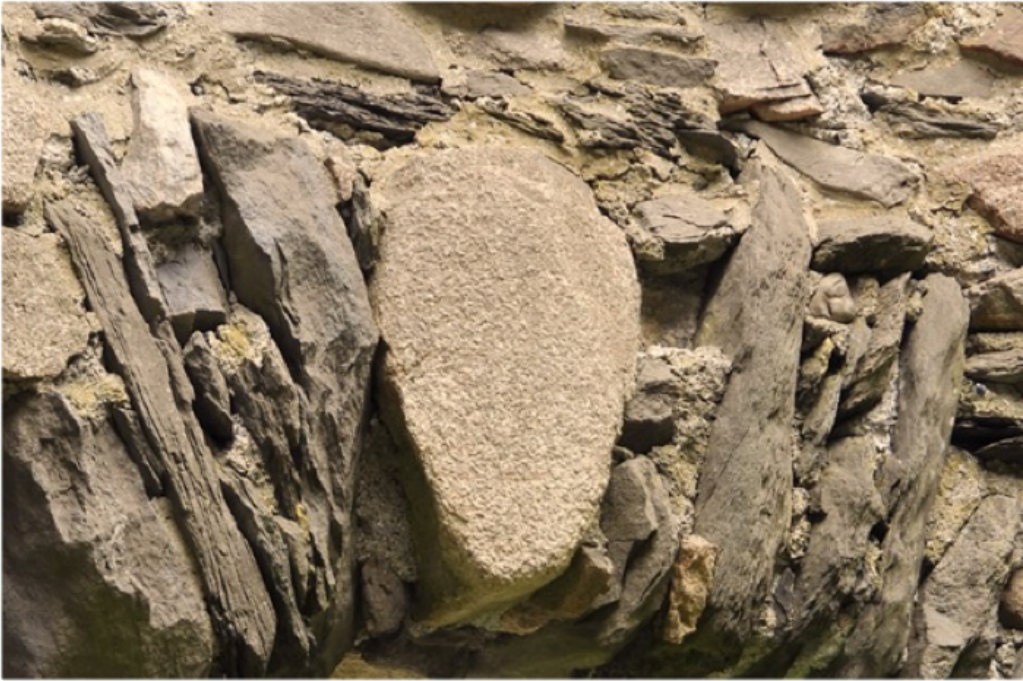
Omphalos stone embedded above the west arch interior in the Newport Tower
IMAGE CREDIT: Photograph by the author. August 2019
The last omphalos stone for consideration is found in North America. It is embedded over the interior western archway of the enigmatic Newport Tower located on a hill at Touro Park in Newport, Rhode Island.
Uncertainty surrounds when and why the Newport Tower was constructed. However, the most reasonable explanation, one put forward by Scott Wolter, is that it was probably built by Henry Sinclair in the late 14th century and has something to do with the Knights Templar.
What is significant about the Newport Tower omphalos is not just that its egg shape symbolizes fertility and the sacred feminine, it is that it performs a fertility rite through solar alignments. This occurs not once but twice!
Wolter [xvii] has proven that on the winter solstice at precisely 9:00 a.m. the omphalos is illuminated by a beam of light coming through the tower’s south window.
The event occurs a second time on 1 May, the pagan fertility holiday of Beltane. When the omphalos is illuminated during these two events the Sun, the celestial father deity, is symbolically impregnating terrestrial Mother Earth, fertilizing the egg in her womb.
So, contrary to initial perception, solar alignments of the Newport Tower omphalos symbolize more than an allegorical resurrection of the Sun.
Interestingly, Newport lies roughly along the 41st parallel north, the same parallel as Rome and Istanbul (Constantinople) that also have omphalos stones.
Washington
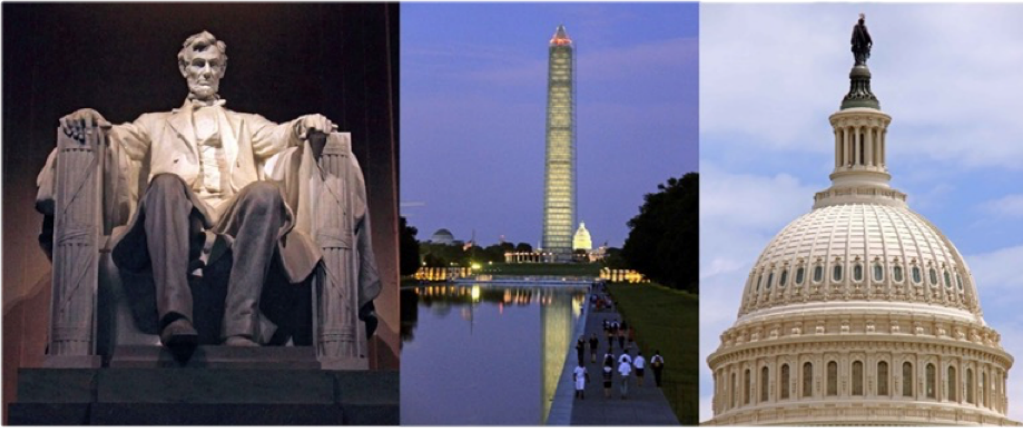
Lincoln at the Lincoln Memorial (left) with his hands upon two pillars, staring out across the reflecting pool toward the illuminated Washington Memorial with the Capitol dome in the background (centre), and Columbia atop the Capitol dome (right) [xxix].
Note the similarity in appearance between a beehive’s queen cell and the Capitol’s dome.
IMAGE CREDIT: Photograph by the author. August 2013
The oculus-dome of the Capitol building in Washington, DC with Columbia on top also represents an omphalos.
It symbolizes emergence of the sacred feminine in America and her union with the sacred masculine represented by the obelisk of the Washington Memorial.
There is a reflection pool of water extending from the obelisk of the Washington Memorial to the Lincoln Memorial.
This reflection pool allegorically symbolizes that from the union of the sky above and Earth below a new masculine nation was born.
On 1 May 1775, the pagan fertility holiday of Beltane, also known as May Day, the Second Continental Congress convened in Philadelphia.
‘The end result of the Congress was the adoption of the Declaration of Independence and creation of a continental army’. [xxiv]
George Washington was elected to lead the Continental Army. It was on this fertility date that a new nation, the United States of America, was conceived with its birth occurring in the Declaration of Independence that states:
‘When in the Course of human events, it becomes necessary for one people to dissolve the political bands which have connected them with another, and to assume among the powers of the earth, the separate and equal station to which the Laws of Nature and of Nature’s God entitle them, a decent respect to the opinions of mankind requires that they should declare the causes which impel them to the separation.’ [xxv]
This conception and birth was also captured in the Articles of Confederation and Perpetual Union that were ratified on1 March 1781 [xxvi] and clearly stated in the preamble of our Constitution as:
We, the people of the United States, in order to form a more perfect Union, establish justice, insure domestic tranquillity, provide for the common defence, promote the general welfare, and secure the blessings of liberty to ourselves and our posterity, do ordain and establish this Constitution for the United States of America. [xxvii]
Abraham Lincoln reinforced the idea of such a union in his first inaugural address on 4 March 1861, when he stated:
‘Descending from these general principles, we find the proposition that in legal contemplation the Union is perpetual confirmed by the history of the Union itself.
The Union is much older than the Constitution. It was formed, in fact, by the Articles of Association in 1774. It was matured and continued by the Declaration of Independence in 1776.
It was further matured, and the faith of all the then thirteen States expressly plighted and engaged that it should be perpetual, by the Articles of Confederation in 1778.
And finally, in 1787, one of the declared objects for ordaining and establishing the Constitution was ‘to form a more perfect Union’. [xxviii]
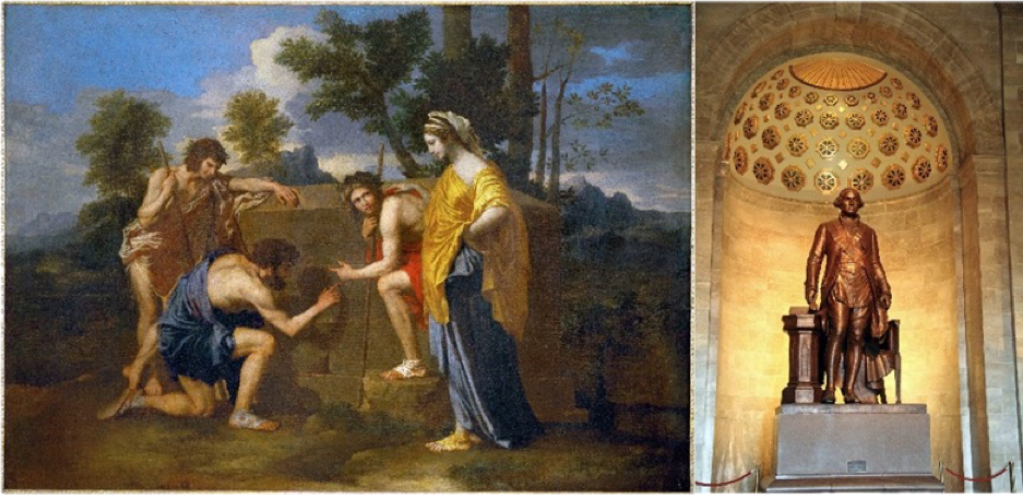
(left) Poussin’s painting Les Bergers d’Arcadie (1637-1638)
IMAGE CREDIT: nicolas-poussin.com/oeuvres/bergers-arcadie-et-in-arcadia-ego-1640/
(right) George Washington standing god-like within an omphalos-womb at the George Washington Masonic Memorial in Alexandria, VA
IMAGE CREDIT: Photograph by the author
We find this union exemplified in nearby Alexandria at the George Washington Masonic Memorial that is on a hill across the Potomac River from Washington, in the District of Columbia.
As an aside, it’s interesting to note that the city ‘Washington, District of Columbia’ denotes the union of the sacred masculine and sacred feminine in its very name.
The George Washington Masonic Memorial has a phallic-like tower containing another womb-shaped oculus-omphalos wherein George Washington stands god-like on a ‘crypt’ beneath a dome consisting of the sun, encircled eight-pointed stars, and ‘oblong squares’ that is supported by a ‘royal arch’ with a keystone.
The sun symbolizes the sacred masculine, George Washington, the ‘father of our nation’.
The encircled eight-pointed stars signify protection of the sacred feminine with the intermingled oblong squares representing the Earth.
The combination of stars and squares therefore symbolize Mother Earth who was revered as Columbia at our nation’s founding.
The keystone within the Royal Arch of this omphalos is analogous to the egg-shaped keystone found in the west arch of the Newport Tower and allegorically suggests conception within the womb.
Note too that there is a pillar adjacent to Washington atop the ‘crypt’.
This pillar is not only reminiscent of ‘Our Lady of the Pillar’ found at Chartres, it’s also suggestive of the Foundation Stone located in what was once the sanctum sanctorum in the Temple of Solomon in Jerusalem as well as the crypt featured in Poussin’s painting Les Bergers d’Arcadie (The Shepherds in Arcadia) that has ‘Et in Arcadia Ego’, meaning ‘in Arcadia I exist’ in reference to America, inscribed upon it.
As such, it may imply a possible connection to artefacts found in Jerusalem by the Templars as detailed in the Cremona Document.
If so, it begs a question…What is contained within the crypt beneath Washington’s feet?
Conclusion
At first blush, when we reflect upon the symbolism of a beehive it does indeed suggest industry and community; working without contention for the common good as espoused in Masonic tenets.
With a little digging we find that a beehive also represents physical and spiritual transformation as an alchemical allegory symbolized as the Philosopher’s Stone.
Digging deeper still we discover that a beehive further symbolizes a Marianist tradition found within Christianity.
Finally, when we uncover its roots, it is revealed that a beehive is represented as omphalos stones, symbolic of the sacred feminine and supreme earth mother of the remote past.
Foot Notes
Reference Sources
[1] Ard is a term of Germanic origin that refers to a rudimentary drawn plough with a spiked head often used to create furrows for planting grain. In ancient times ritual use of an ard by men coincided with the Big Dipper, also known as the plough, appearing as a plough in the late winter night sky. Ploughing furrows symbolized fertility and the beginning of spring planting. As such, Aard is an ancient goddess of grain and fertility. Ard is also a Gaelic term for a rocky place and Irish for high or tall. In the Gallo-Roman religion Arduinna (also known as Arduina, Arduinnae or Arduinne) is the eponymous tutelary goddess of the Ardennes Forest and region often depicted holding a spear while riding a boar. As a huntress and guardian of the forest she is associated with the Roman goddess Diana and Irish goddess Flidais.
[2] The Cross of Hathor is also known as an ankh.
[i] Hogan, Timothy. The Alchemical Keys to Masonic Ritual. Pg. 25. Lulu. 2007. ISBN: 978-1-4357-0440-4.
[ii] Sherer, John. Master’s Carpet. Pettibone Bros., Cincinnati. 1868.
[iii] Dianthus – Flowers of the Gods. Life is a Garden. https://www.lifeisagarden.co.za/dianthus-flowers-of-the-gods/. Accessed January 5, 2020.
[iv] The Dianthus is a Flower of God at a less subtle level than that conveyed. Paternal advocates may classify the Dianthus as being the masculine flower of Zeus, but that’s not quite right. It’s two-fold in that Di means in two but signifies the whole union and points to the Titan water nymph goddess Dione, the first wife of Zeus, as the feminine part of God on Mount Olympus. Dione was worshipped alongside Zeus at Greece’s earliest oracle at Dodona. Her priestesses and prophetesses were known as Pleiades or doves, the sacred bird of their daughter Aphrodite, goddess of love, beauty, sexual pleasure, and fertility whose attributes were derived from the Mesopotamian mother goddess, Ishtar. The name Dianthus is derived from the Greek words Dios, meaning “of Zeus”, and Anthos, meaning “flower” as cited by Theophrastus (c. 371 – 287 BC). Now here’s an interesting twist to it… Theophrastus was born in the town of Eresos on the Isle of Lesbos, home of the tenth Muse, Sapho. Sapho (c. 630 – 570 BC), who was also born in Eresos, is well known as a symbol of love and desire between women. After the death of Sapho and shortly before the birth of Theophrastus, between 431 BC and 404 BC, Greek culture was influenced by the Spartans. Under these influences we can appreciate why Theophrastus named the flower Dianthus. Thus, the Dianthus flower alludes to both the male aspect of God through its association with Zeus and the sacred feminine in its association with both Dione and Aphrodite, establishing a trinity analogous to Jesus, the Virgin Mary, and Mary Magdalene as well as that of the earlier Sumerian Tammuz, Inanna/Ishtar, and Geshtinanna.
[v] Connor, Larry. Colony Development Part I: Importance of knowing Developmental Rates. Bee Culture: The Magazine of American Beekeeping. Sept 19, 2015. https://www.beeculture.com/colony-development-part-i/. Accessed January 10, 2020.
[vi] Photographs by the author who is a beekeeper
[vii] Sutherland, A. Omphalos – Mysterious Ancient Sacred Object and Its Meaning. AncientPages.com. May 24, 2017. http://www.ancientpages.com/2017/05/24/omphalos-mysterious-ancient-sacred-object-and-its-meaning/. Accessed January 6, 2020.
[viii] Ibid.
[ix] Ibid.
[x] Radford, Benjamin. The Lore and Lure of Ley Lines. Live Science. November 20, 2013. https://www.livescience.com/41349-ley-lines.html. Accessed January 5, 2020.
[xi] Earth Navels. Ancient Wisdom. http://www.ancient-wisdom.com/earthnavels.htm. Accessed January 5, 2020.
[xii] Sutherland, A. Omphalos – Mysterious Ancient Sacred Object and Its Meaning. AncientPages.com. May 24, 2017. http://www.ancientpages.com/2017/05/24/omphalos-mysterious-ancient-sacred-object-and-its-meaning/. Accessed January 6, 2020.
[xiii] Wikipedia contributors, “Omphalos,” Wikipedia, The Free Encyclopedia, https://en.wikipedia.org/w/index.php?title=Omphalos&oldid=929036100. Accessed January 4, 2020.
[xiv] Earth Navels. Ancient Wisdom. http://www.ancient-wisdom.com/earthnavels.htm. Accessed January 5, 2020.
[xv] Ibid.
[xvi] Harden, David Guy. Christian Saint, Pagan Priest The Untold Story of Templars, Masons, and the Catholic Church: A Biography of St. Stephen Harding. Pg. 8. Academia.edu. https://www.academia.edu/36560280/Christian_Saint_Pagan_Priest_The_Untold_Story_of_Templars_Masons_and_the_Catholic_Church._A_Biography_of_St._Stephen_Harding._Version_December_28_2018.
[xvii] Harden, David Guy. Christian Saint, Pagan Priest The Untold Story of Templars, Masons, and the Catholic Church: A Biography of St. Stephen Harding. Pg. 11. Academia.edu. https://www.academia.edu/36560280/Christian_Saint_Pagan_Priest_The_Untold_Story_of_Templars_Masons_and_the_Catholic_Church._A_Biography_of_St._Stephen_Harding._Version_December_28_2018.
[xviii] Harden, David Guy. Christian Saint, Pagan Priest The Untold Story of Templars, Masons, and the Catholic Church: A Biography of St. Stephen Harding. Pg. 624. Academia.edu. https://www.academia.edu/36560280/Christian_Saint_Pagan_Priest_The_Untold_Story_of_Templars_Masons_and_the_Catholic_Church._A_Biography_of_St._Stephen_Harding._Version_December_28_2018
[xix] Ibid.
[xx] Silva, Freddie. Chartres Cathedral: The Missing or Heretic Guide. Invisible Temple, 2015. Kindle eBook. ASIN: B01460ITCU
[xxi] Rozett, Ella. Zaragoza. Interfaith Mary; 2019. http://interfaithmary.net/blog/zaragoza. Accessed 28 Dec 2019.
[xxii] Wolter, Scott F. Cryptic Code of the Templars in America: Origins of the Hooked X Symbol. Pp. 10 and 90-91. North Star Press. 2019. ISBN: 978-1-68201-101-0.
[xxiii] Photograph by the author. August 2019.
[xxiv] May 1,1775 – Second Continental Congress. Time Graphics. https://time.graphics/event/1757122. Accessed January 13, 2020.
[xxv] Declaration of Independence: A Transcription. National Archives, America’s Founding Documents. https://www.archives.gov/founding-docs/declaration-transcript. Accessed January 13, 2020.
[xxvi] Articles of Confederation. The Avalon Project, Lillian Goldman Law Library, Yale Law School. 2008. https://avalon.law.yale.edu/18th_century/artconf.asp. Accessed January 12, 2020.
[xxvii] Constitution of the United States: Preamble. The Avalon Project, Lillian Goldman Law Library, Yale Law School. 2008. https://avalon.law.yale.edu/18th_century/preamble.asp. Accessed January 12, 2020.
[xxviii] First Inaugural Address of Abraham Lincoln. The Avalon Project, Lillian Goldman Law Library, Yale Law School. 2008. https://avalon.law.yale.edu/19th_century/lincoln1.asp. Accessed January 12, 2020.
[xxix] Photographs by the author. 2013.
Article by: Dr Richard Kretz

Dr Richard Kretz holds a B.S. in Sociology and Business Management and a M.S. and PhD in Education.
He has had a lifelong interest in nature and the esoteric, spent three years with a Native American shaman, and is a member of The Explorers Club.
Dr Kretz is a Master Mason who has earned the Knight York Cross of Honor (KYCH), is a Knight Mason, Companion of the York Rite Sovereign College of North America (YRC), Knight Companion of the Red Cross of Constantine, 32nd degree Scottish Rite Mason, Knight in the Royal Order of Scotland, Frater of the Societas Rosicruciana in Civitatibus Foederatis (SRICF), and Brother in the Martinist Order of Unknown Philosophers (MOUP).
He is available to provide presentations and lectures as appropriate on nature, exploration, Masonry, and the Knights Templar.
Recent Articles: symbolism
 The Practice of Freemasonry - P1 Embark on a transformative journey with Freemasonry, where the exploration of your Center unlocks the Perfect Ashlar within. Through the practices of Brotherly Love, Relief, Truth, and Cardinal Virtues, discover a path of enlightenment and self-improvement. Embrace the universal creed that binds us in the pursuit of our true essence. |
 Discover the fascinating history and significance of the Warrant of Constitution within Freemasonry. Unveil the evolution of this crucial authorization, its role in legitimizing Lodges, and its lasting impact on the global brotherhood of Freemasons. Explore the intricate link it provides between tradition and modern practice. |
 Freemasonry: Unravelling the Complexity of an Influential Organization Mysterious and captivating, Freemasonry has piqued the interest of seekers and skeptics alike. With its intricate blend of politics, esotericism, science, and religion, this enigmatic organization has left an indelible mark on society. Prepare to delve into the secrets of Freemasonry and unlock its hidden depths. |
 Unlocking the Mysteries of Freemasonry: In the hallowed halls of Freemasonry, a powerful symbol lies at the heart of ancient rituals and teachings—the Volume of the Sacred Law. This sacred book not only guides the spiritual and moral journey of Freemasons but also serves as a beacon of universal wisdom and enlightenment. |
 The Ancient Liberal Arts in Freemasonry Embark on a journey of self-improvement and wisdom with Freemasonry's guiding principles. Ascend the winding stairs of moral cultivation, analytical reasoning, and philosophical understanding. Embrace arithmetic's mystical properties and geometry's universal truths. Let the harmony of the universe inspire unity and growth. Discover the profound, hidden knowledge in Freemasonry's path to enlightenment. |
 Initiation rituals around the world are filled with fascinating elements and different images. One of them is that of darkness. When societies speak of darkness, they often mean a lack of knowledge, a lack of choice, or a symbol of evil. During initiation rituals, darkness is used to represent the initiate's lack of knowledge about the world, society, and initiation in general. It can also represent the initiate's inability to make a choice or endure a situation. Whether you have participated in an initiation rite or not, the meaning of darkness remains an intriguing concept worth exploring. Initiation rituals around the world are filled with fascinating elements and different images. One of them is that of darkness. When societies speak of darkness, they often mean a lack of knowledge, a lack of choice, or a symbol of evil. During initiation rituals, darkness is used to represent the initiate's lack of knowledge about the world, society, and initiation in general. It can also represent the initiate's inability to make a choice or endure a situation. Whether you have participated in an initiation rite or not, the meaning of darkness remains an intriguing concept worth exploring. |
 Masonic Deacon rods potentially trace their origins to Greek antiquity, symbolically linked to Hermes' caduceus. As Hermes bridged gods and mortals with messages, so do Masonic Deacons within the lodge, reinforcing their roles through ancient emblems. This connection underscores a profound narrative, weaving the fabric of Masonic rites with the threads of mythological heritage, suggesting the rods are not mere tools but bearers of deeper, sacred meanings that resonate with the guardianship and communicative essence of their divine counterpart, Hermes, reflecting a timeless lineage from myth to Masonic tradition. |
 The biblical pillars erected by Solomon at the Temple's porch, hold a profound place in history. These brass behemoths are not mere decorations; they are symbols of strength, establishment, and divine guidance. Explore their fascinating construction, dimensions, and the deep meanings they carry in both biblical and Masonic contexts. |
 Unlocking the Mind's Potential: Dive deep into ground breaking research revealing how simple daily habits can supercharge cognitive abilities. Discover the untapped power within and redefine your limits. Join us on this enlightening journey and transform your world! |
 Dive deep into the symbolic importance of the trowel in Masonry, representing unity and brotherly love. From its historical roots in operative masonry to its significance in speculative masonry, this article explores the trowel's multifaceted role. Discover its connection to the sword, the story of Nehemiah, and the Society of the Trowel in Renaissance Florence. Unravel the layers of meaning behind this enduring Masonic symbol. |
 Symbolism of The Builder's Jewel Batty Langley's "The Builder’s Jewel" (1741) is a visual masterpiece of Masonic symbolism, showcasing Langley's deep understanding of Freemasonry. The frontispiece highlights key symbols like the three pillars and the legend of Hiram Abiff, emphasizing Langley's dedication to Masonic traditions and teachings. |
 Unveil the mystique of the colour blue in Masonic symbolism. A hue evoking universal friendship and benevolence, its roots span ancient cultures, infusing Freemasonry's core values. This article explores blue's profound significance, guiding Freemasons towards wisdom and spiritual enlightenment. Discover the fascinating journey of this universal symbol. |
 Discover the intriguing world of the plumb in Masonic symbolism with our in-depth analysis. Uncover its rich history, moral teachings, and significance in Freemasonry, guiding members on their path to truth, integrity, and justice. Immerse yourself in the captivating power of this symbol that shapes lives within the brotherhood. |
 Unlock the mysteries of Freemasonry with 'The Key,' a profound Masonic symbol. This seemingly simple instrument holds a deeper meaning, teaching virtues of silence and integrity. Explore its ancient roots, from Sophocles to the mysteries of Isis, and discover how it symbolizes the opening of the heart for judgment. |
 Unlock the secrets of the Freemasonry with The Blazing Star - a symbol that holds immense significance in their rituals and practices. Delve into its history, meaning and role in the different degrees of Freemasonry with expert insights from the Encyclopedia of Freemasonry by Albert Mackey. Discover the mystique of The Blazing Star today! |
 There is no symbol more significant in its meaning, more versatile in its application, or more pervasive throughout the entire Freemasonry system than the triangle. Therefore, an examination of it cannot fail to be interesting to a Masonic student. Extract from Encyclopedia of Freemasonry by Albert Mackey |
 The Hiramic Legend and the Myth of Osiris Hiram Abiff, the chief architect of Solomon’s Temple, is a figure of great importance to Craft Freemasonry, as its legend serves as the foundation of the Third Degree or that of a Master Mason. He is the central figure of an allegory that has the role of teaching the Initiate valuable alchemical lessons. Although his legend is anchored in biblical times, it may have much older roots. |
 This rite of investiture, or the placing upon the aspirant some garment, as an indication of his appropriate preparation for the ceremonies in which he was about to engage, prevailed in all the ancient initiations. Extract from The Symbolism of Freemasonry by Albert G. Mackey |
 The All-Seeing Eye of God, also known as the Eye of Providence, is a representation of the divine providence in which the eye of God watches over humanity. It frequently portrays an eye that is enclosed in a triangle and surrounded by rays of light or splendour. |
 What's in a Word, Sign or Token? Why do Freemasons use passwords, signs, and tokens? As Freemasons we know and understand the passwords, signs and tokens (including grips), which are all used a mode of recognition between members of the fraternity. |
 A Temple of Living Stones: Examining the Concept of a Chain of Union What are the origins of the Chain of Union? And how did they come about ? The answers may surprise some members as W Brother Andrew Hammer investigates, author of Observing the Craft: The Pursuit of Excellence in Masonic Labour and Observance. |
 One of the best loved stories for the festive season is ‘A Christmas Carol’. A traditional ghost story for retelling around the fire on a cold Christmas Eve, it is a timeless classic beloved by those from all walks of life. Philippa explores the masonic allegory connections… |
 The Trowel - Working Tool of the Master Mason The Trowel is the symbol of that which has power to bind men together – the cement is brotherhood and fellowship. |
 Two Perpendicular Parallel Lines The point within a circle embordered by two perpendicular parallel lines, with the Holy Bible resting on the circle, is one of the most recognizable symbols in Freemasonry. It is also one which always raises a question. How can two lines be both perpendicular and parallel? |
 "The first great duty, not only of every lodge, but of every Mason, is to see that the landmarks of the Order shall never be impaired." — Albert Mackey (1856) |
 It is common knowledge that the ancient wages of a Fellowcraft Mason consisted of corn, wine, and oil. |
 “Do not come any closer,” God said. “Take off your sandals, for the place where you are standing is holy ground.” Exodus 3:5 |
 The Secret Language of the Stone Masons We know of Masons' Marks but lesser known are the 'argots' used by the artisans - in part 2 of a series on the social history of the Operative Masons we learn how the use of secret languages added to the mystery of the Guilds. |
 The phrase appears in the Regius Poem. It is customary in contemporary English to end prayers with a hearty “Amen,” a word meaning “So be it.” It is a Latin word derived from the Hebrew word - Short Talk Bulletin - Vol. V June, 1927, No.6 |
 Egypt's 'Place of Truth' - The First Operative Stone Masons' Guild? Was ancient Egypt's 'village of the artisans' the first operative stone masons' guild? And was their use of 'identity marks' a forerunner of the Mason's Marks of the cathedral builders of the Middle Ages? Read on for some possible answers… |
 The Pieces of Architecture and the Origin of Masonic Study Discover the journey of the Apprentice – from Operative to Speculative. This journey has been carried out since the times of operative Freemasonry but today the initiate works in the construction of his inner temple. |
 The Builders' Rites - laying the foundations operatively and speculatively The cornerstone (also ‘foundation’ or ‘setting’ stone) is the first stone to be set in the construction of the foundations of a building; every other stone is set in reference to this. |
 Applying the working tools to achieve our peculiar system of morality. |
 We take an in-depth look at the 47th Proposition of the 1st Book of Euclid as part of the jewel of the Past Master. |
 The Cable Tow: Its Origins, Symbolism, & Significance for Freemasons - Unbinding the significance of the cable tow. |
 We examine at one of the most impressive moments of the initiatory ceremony, a certain rite known as Circumambulation, and ask what is its meaning and purpose ? |
 So, what is the Level? And why do we use it in Freemasonry? |
 What is the mysterious pigpen or Masonic cipher that has been used for centuries to hide secrets and rituals? |
 The Story of the Royal Arch - The Mark Degree Extracted from William Harvey's 'The Story of the Royal Arch' - Part 1 describes the Mark Degree, including the Working Tools. |
 Ashlars - Rough, Smooth - Story of a Stone How we can apply the rough and smooth Ashlars with-in a masonic context |
 A detailed look at the Chamber of Reflection: A Revitalized and Misunderstood Masonic Practice. |
 Exploring the origin and symbolism of Faith, Hope and Charity |
 The Noachite Legend and the Craft What is it to be a true Noachidae, and what is the Noachite Legend and the Craft ? |
 In Masonic rituals, Jacob’s ladder is understood as a stairway, a passage from this world to the Heavens. |
 What is the meaning of the Acacia and where did it originate ? |
 What is the connection with the Feasts of St John and Freemasonry |
 The Forget-Me-Not and the Poppy - two symbols to remind us to 'never forget' those who died during the two World Wars. |
 Biblical history surrounding the two pillars that stood at the entrance to King Solomon's Temple |
 Is there a direct link between Judaism and Freemasonry? |
 The symbolism of the beehive in Masonry and its association with omphalos stones and the sacred feminine. |
 The Wages of an Entered Apprentice |
 An explanation of the North East corner charge which explores beyond one meaning Charity - |
 A brief look at the origins of the two headed eagle, probably the most ornamental and most ostentatious feature of the Supreme Council 33rd Degree Ancient and Accepted (Scottish ) Rite |
 A Muslim is reminded of his universal duties just as a Freemason. A Masonic Interpretation of the Quran's First Two Chapters |
 The three Latin words -{Listen, Observe, Be Silent}. A good moto for the wise freemason |
masonic knowledge
to be a better citizen of the world
share the square with two brothers

click image to open email app on mobile device
Tubal Cain
Masonic Aprons NFT
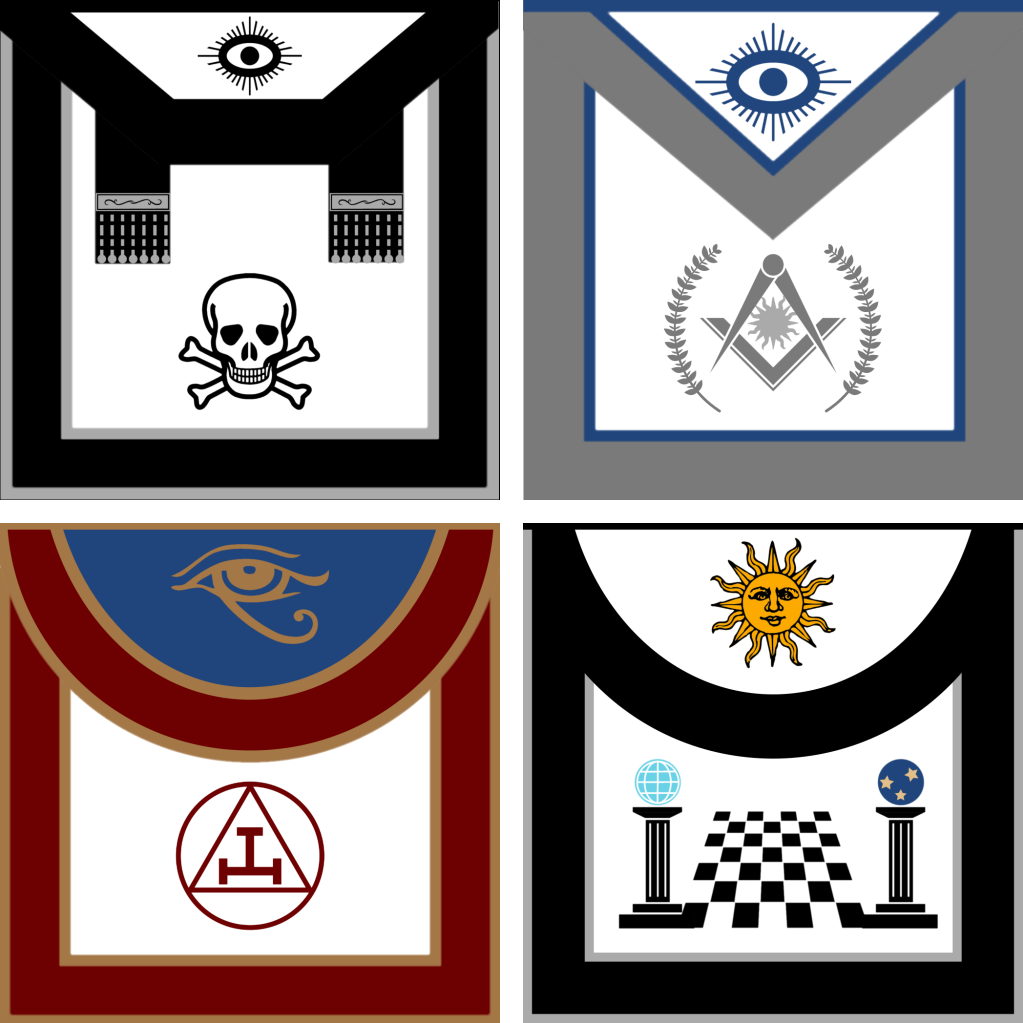



Each Tubal Cain Masonic Apron NFT JPEG includes a full size masonic apron and worldwide shipping
